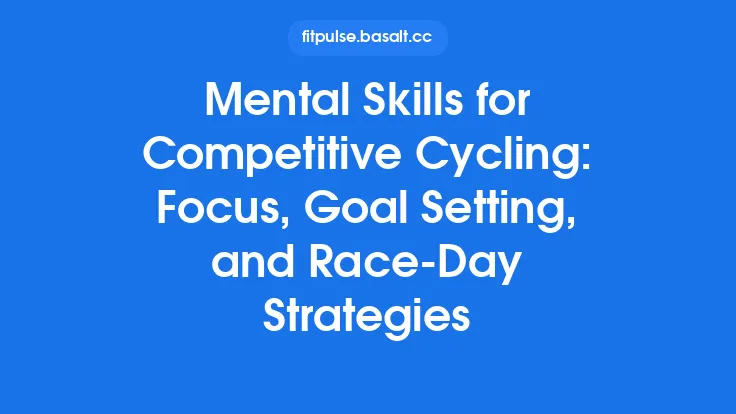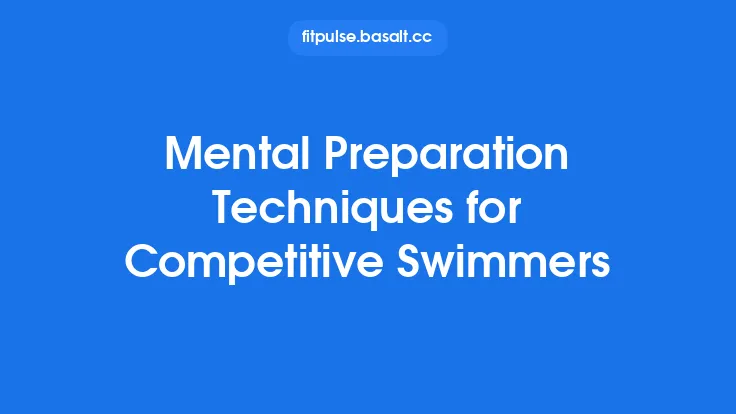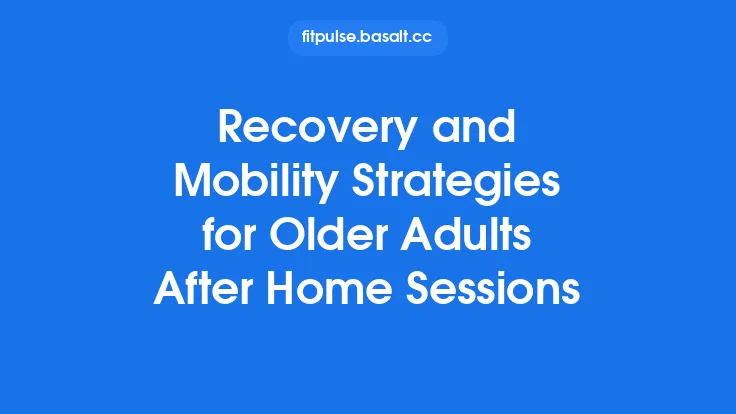Building a resilient mindset is more than a buzz‑word; it is a systematic, evidence‑based approach to safeguarding mental health over the long haul. Athletes, coaches, and anyone who pushes their bodies to the limit face inevitable setbacks—injuries, plateaus, or periods of under‑performance. While physical rehabilitation protocols are well‑documented, the mental side of recovery often receives less structured attention. This article outlines a comprehensive framework for cultivating mental resilience that can sustain long‑term recovery, enhance performance, and protect against future setbacks.
Understanding Resilience as a Skill, Not a Trait
Resilience is frequently described as an innate personality characteristic, but contemporary research frames it as a set of learnable skills. The brain’s capacity for adaptation—rooted in neuroplasticity—means that repeated practice of specific mental strategies can rewire neural pathways associated with stress appraisal, emotional regulation, and problem‑solving. By treating resilience as a skill set, individuals can deliberately train and measure progress, much like any physical attribute.
Key components of a resilient mindset include:
| Component | Description | Practical Indicator |
|---|---|---|
| Psychological Flexibility | Ability to adapt thoughts and actions to changing circumstances without rigid adherence to a single narrative. | Shifts perspective when a training plan fails. |
| Emotional Regulation | Managing the intensity and duration of emotional responses. | Returns to baseline mood within 15‑30 minutes after a disappointment. |
| Self‑Compassion | Treating oneself with kindness during failure, rather than harsh self‑criticism. | Uses supportive language when reviewing a poor performance. |
| Growth Orientation | Viewing setbacks as opportunities for learning rather than evidence of inadequacy. | Identifies at least one lesson after each injury. |
| Purpose Alignment | Connecting daily actions to a broader, personally meaningful goal. | Can articulate how a recovery day contributes to long‑term aspirations. |
The Four‑P Model for Mental Recovery
A useful scaffold for building resilience is the Four‑P Model: Preparation, Perspective, Practice, and Persistence. Each pillar addresses a distinct phase of the recovery journey.
Preparation: Laying the Groundwork Before Setbacks Occur
- Baseline Mental Health Assessment
- Conduct a brief, standardized questionnaire (e.g., the Depression Anxiety Stress Scales) quarterly to establish a mental health baseline.
- Track changes over time to detect early warning signs.
- Recovery Blueprint
- Draft a written plan that outlines expected recovery milestones, support resources, and contingency actions for potential obstacles.
- Include “what‑if” scenarios (e.g., delayed healing, loss of motivation) and pre‑planned coping responses.
- Environmental Optimization
- Curate a physical environment that minimizes distractions and promotes focus: dedicated recovery space, ergonomic furniture, and controlled lighting.
- Manage digital exposure by setting boundaries on social media and news consumption, especially during high‑stress periods.
Perspective: Reframing Setbacks Through Cognitive Strategies
- Cognitive Reappraisal
- Practice reinterpreting a negative event in a neutral or positive light. For instance, view a missed training session as an opportunity to refine technique rather than a failure.
- Use a structured worksheet: Situation → Automatic Thought → Evidence For/Against → Balanced Thought.
- Narrative Reconstruction
- Write a brief “recovery story” that integrates the setback into a larger personal narrative of growth. This helps shift the mental focus from a single event to an ongoing journey.
- Value‑Based Anchoring
- Identify core values (e.g., perseverance, learning, community) and link daily recovery actions to these values. When motivation wanes, revisiting the value list can reignite purpose.
Practice: Embedding Resilience‑Building Habits
- Micro‑Reflection Sessions
- Allocate 5‑10 minutes at the end of each day to answer three prompts: What went well? What challenged me? What will I try tomorrow?
- Record answers in a simple log (paper or digital) to create a habit loop of reflection and adjustment.
- Scheduled “Mental Load” Days
- Designate low‑intensity days where the primary focus is mental recovery (e.g., light mobility work, strategic planning). This prevents cumulative mental fatigue and reinforces the habit of intentional rest.
- Skill‑Specific Drills
- Emotional Regulation Drill: When a strong emotion arises, pause, label the feeling, and choose a regulation strategy (deep exhalation, progressive muscle relaxation, or brief physical movement).
- Flexibility Drill: Choose a routine task (e.g., warm‑up) and intentionally vary one element (order, duration, equipment) to practice adaptability.
- Social Reinforcement
- Pair up with a “recovery buddy” who provides accountability and perspective. Regular check‑ins (weekly or bi‑weekly) can surface blind spots and reinforce commitment.
Persistence: Sustaining Momentum Over the Long Term
- Progress Metrics Beyond Performance
- Track mental recovery markers such as average mood rating, sleep quality score, and frequency of self‑compassionate statements. These metrics often predict physical performance more reliably than raw training numbers.
- Periodic Review and Adjustment
- Every 4–6 weeks, review the recovery blueprint, mental health assessments, and habit logs. Adjust goals, introduce new coping strategies, or modify environmental factors as needed.
- Celebrating Process Milestones
- Recognize and reward adherence to mental recovery habits (e.g., completing a month of consistent micro‑reflections). Rewards can be non‑material (extra leisure time, a favorite healthy meal) to reinforce intrinsic motivation.
Neurocognitive Foundations Supporting Resilience Training
While the article avoids deep dives into neuroplasticity as a standalone topic, a brief technical overview helps explain why the strategies above are effective.
- Prefrontal Cortex (PFC) Strengthening: Repeated cognitive reappraisal and flexible problem‑solving engage the dorsolateral PFC, enhancing its capacity to regulate the amygdala’s threat response. Over time, this leads to quicker emotional down‑regulation after setbacks.
- Default Mode Network (DMN) Modulation: Structured reflection and narrative reconstruction shift DMN activity from rumination (self‑referential negative looping) to purposeful self‑integration, reducing the risk of depressive spirals.
- Hippocampal Consolidation: Consistent sleep hygiene and stress‑free recovery days support hippocampal memory consolidation, allowing learned resilience skills to become more automatic.
Understanding these mechanisms underscores the importance of regular practice and environmental control in cementing resilient mental patterns.
Integrating Physical and Mental Recovery: A Holistic Schedule
A practical weekly template illustrates how mental resilience work can coexist with physical training without overloading the athlete.
| Day | Physical Component | Mental Resilience Component |
|---|---|---|
| Monday | Strength session (moderate load) | 10‑minute cognitive reappraisal after training |
| Tuesday | Light cardio + mobility | 5‑minute micro‑reflection before bed |
| Wednesday | Skill work (high focus) | Value‑based anchoring exercise (15 min) |
| Thursday | Rest or active recovery | Scheduled “mental load” day (strategic planning) |
| Friday | Interval training | Emotional regulation drill post‑session |
| Saturday | Long endurance work | Social check‑in with recovery buddy |
| Sunday | Full rest | Review of weekly metrics and adjustment of blueprint |
The schedule intentionally alternates higher physical stress days with targeted mental recovery activities, ensuring that neither domain overwhelms the other.
Common Pitfalls and How to Avoid Them
| Pitfall | Why It Undermines Resilience | Countermeasure |
|---|---|---|
| All‑or‑Nothing Thinking | Leads to abandonment of recovery plans after a single slip. | Adopt a “progress, not perfection” mindset; log even partial adherence. |
| Over‑Reliance on External Validation | Creates dependency on coach or peer approval, weakening internal motivation. | Strengthen self‑compassion practices; set internal criteria for success. |
| Neglecting Sleep Hygiene | Impairs PFC function, reducing capacity for emotional regulation. | Implement a consistent bedtime routine; limit screen exposure 30 min before sleep. |
| Ignoring Social Isolation | Reduces access to perspective‑shifting feedback and emotional support. | Schedule regular, low‑pressure social interactions (e.g., coffee with a teammate). |
| Skipping Routine Reviews | Allows maladaptive patterns to persist unnoticed. | Set calendar reminders for quarterly blueprint reviews. |
Measuring Success: Objective and Subjective Indicators
A resilient mindset is not a static endpoint but a dynamic state that can be quantified and qualified.
- Objective Indicators
- Recovery Adherence Rate: Percentage of planned mental recovery activities completed each week.
- Mood Variability Index: Standard deviation of daily mood scores (lower variability suggests stability).
- Sleep Efficiency: Ratio of time asleep to time in bed (target >85 %).
- Subjective Indicators
- Perceived Control: Self‑rated sense of control over recovery outcomes (scale 1‑10).
- Self‑Compassion Scale: Frequency of kind self‑talk during setbacks.
- Purpose Alignment Rating: How strongly daily actions feel connected to long‑term goals.
Regularly reviewing both sets of data provides a comprehensive picture of mental recovery health and highlights areas needing reinforcement.
A Blueprint for the First 90 Days
Weeks 1‑2: Foundations
- Complete baseline mental health assessment.
- Draft recovery blueprint with “what‑if” scenarios.
- Begin daily micro‑reflection (5 min).
Weeks 3‑6: Skill Building
- Introduce cognitive reappraisal worksheet twice weekly.
- Schedule first “mental load” day.
- Pair with a recovery buddy for weekly check‑ins.
Weeks 7‑12: Integration & Optimization
- Add emotional regulation drills post‑training.
- Review and adjust blueprint based on metric trends.
- Celebrate completion of the first 90‑day cycle with a non‑training reward.
After the initial 90 days, repeat the cycle with increased complexity (e.g., longer reflection periods, additional reappraisal scenarios) to continue strengthening resilience.
Final Thoughts
A resilient mindset is the cornerstone of sustainable mental recovery. By treating resilience as a trainable skill, employing the Four‑P Model, and embedding evidence‑based habits into daily life, athletes and active individuals can navigate setbacks with confidence, maintain psychological equilibrium, and ultimately enhance both recovery speed and long‑term performance. The strategies outlined here are evergreen—rooted in robust cognitive science and adaptable to any sport, fitness level, or life circumstance. Consistency, self‑compassion, and purposeful reflection are the true catalysts that turn adversity into a springboard for growth.





